Subtotal: $
Checkout-

The Wonder of Moths
-

The Leper of Abercuawg
-

Dandelions: An Apology
-

A Wilderness God
-

Why I Hunt
-

Reading the Book of Nature
-

Breakwater
-

Lambing Season
-

Earthworks Urban Farm
-

Are You a Tree?
-

Practicing Christianity
-

Who Gets to Tell the Story?
-

A Medievalist Looks for the Image of Christ
-

In Defense of Chastity
-

Poem: “Let Them Grow”
-

Poem: “Squall”
-

Readers Respond
-

GEDs for Myanmar Migrants
-

Inside Nyansa Classical Community
-

Watching the Geminids
-

A World Full of Signs
-

Covering the Cover: The Riddle of Nature
-

Back from Walden Pond
-

Can Masculinity Be Good?
-

Nature Is Obsessed with Me
-

Ancient Songs in the Desert
-

The Sadness of the Creatures
-

Meeting the Wolf
-

Saskatchewan, Promised Land
-

The Plants Can Talk

Saving the Soil, Saving the Farm
Regenerative agriculture helps farmers care for the land and pay the bills.
By Colin Boller
February 27, 2024
In a world where industrialization and modernization often dictate the course of progress, a revolutionary shift is taking root in the heart of agriculture. The movement toward regenerative farming practices is not just about adopting the latest scientific advancements; it’s a return to the wisdom of the farmers who have worked the land for generations. Farms are businesses that require financial sustainability. Better growing practices must align with economic viability, saving costs and boosting profits to ensure the survival of farms and those who run them.
Regenerative agriculture is an approach to farming that focuses on revitalizing and strengthening the health of the land and its ecosystems by prioritizing practices that promote soil health, biodiversity, and carbon sequestration while reducing the reliance on synthetic chemical pesticides and fertilizers. The economic and environmental incentives, along with the clear connection between the quality of food and our health, all point to a bright future for regenerative farming. A critical next step is helping farmers overcome the practical barriers preventing them from fully realizing this vision for farming.
The Green Revolution during the past century made many advances in farm productivity. However, it did so at the cost of the soil, severely damaging and depleting the soil’s microbial ecosystem, leaving farmers dependent on carbon-intensive traditional fertilizers and government subsidies. Economic volatilities such as price increases and supply-chain shortages put farms under crippling financial strain.
We now know that prolonged use of chemicals results in the loss of biodiversity in the microbiome, which reduces nutrient availability and causes the breakdown of soil aggregate structure at the microscopic level, leading to soil compaction and erosion and to compromised plants that are more susceptible to pests and diseases while producing nutrient-impoverished crops. As the soil deteriorates and erosion increases, runoff carries a greater amount of fertilizers into surrounding waterways. More fertilizer is required to supplement what was lost, only to wash away again. This cycle is costly and threatens the future viability of the farm.
Fortunately, there is a solution. Farmers are increasingly focusing on regenerating soil health by enhancing soil structure, fertility, and resilience. Driven by new scientific understanding of the role of microbes in the health of the soil, practices such as reducing tillage, cover cropping, crop rotations, and animal integrations are increasing in popularity. As Elaine Ingham, founder of the Soil Food Web School, puts it: “If we want clean water, we have to get the biology back in our soils. If we want to grow and harvest crops, we have to build soil and fertility with time, not destroy it. The only way to reach these endpoints is to improve the life in the soil.”
A growing number of farmers are looking to rebuild the microbial ecosystem by adding beneficial microbes into the soil. These microbes can be grown using specific composting systems, such as vermicomposting, and then extracted into a liquid form that can be applied in furrow with the seed at planting or used as a seed coating, soil drench, or foliar spray. This approach can accelerate the transition toward healthier soils while providing a low cost, environmentally friendly alternative to chemical applications. While adoption of this practice is still in its infancy, with only a fraction of American farmland being actively improved though regenerative methods, the results so far have been exceptionally promising.
Rick Clark farms seven thousand acres of soybeans, alfalfa, and grain crops in western Indiana, where he has defied the limits of what is feasible with regenerative farming at scale. He has eliminated synthetic fertilizers and reduced his diesel fuel consumption by 50 percent, which together saves him $2.7 million a year, leaving some seed and machinery costs as his only major input expenses.
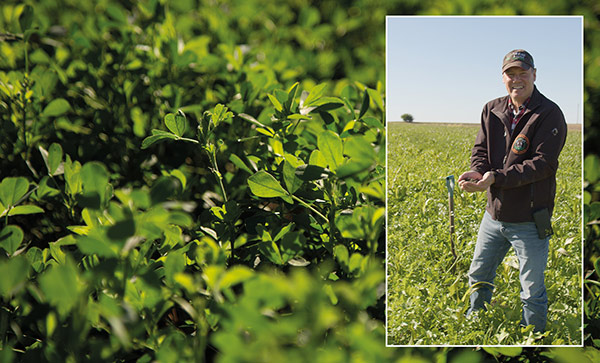
Rick Clark farms soybeans, alfalfa, and grain crops in Indiana. All photography by Ray Mommsen. Used by permission.
Cover cropping and diversifying crops have resulted in less total yield per acre annually but more profitability – that is, a smaller harvest overall, but a better return on investment. “When you start to look at the savings that you get from the reduction or elimination of inputs, you then start to shift away from a yield-driven mindset. This is a profitability mindset,” he says, also noting that his farm achieves the rare trifecta of “regenerative, organic, with no tillage.”
Meanwhile, he’s also bringing seed costs close to zero by developing his own supply: “The beans we harvest this year, we will clean them, and that’s where we’ll get our supply for next year’s bean fields,” he explains. This means that the five varieties of soybeans he grows are adapted to the specific land they’re on, symbiotically in tune with the microbes in the biome. Further, over generations, the beans develop heritable changes to benefit future crops – not only via the evolution of the genome but more rapidly via epigenetic responses to external conditions. In short, he expects his crop to be better suited to the land it’s on with every passing year.
Across the country from Clark, Douglas Poole is on the same wavelength. He farms wheat on fifteen thousand acres of marginal farmland with eight inches of annual rainfall in central Washington, farmland his father bought and harvested with a $15,000 combine. Today, Poole notes, the combine he would need on that land would run him a million dollars – yet neither the yield nor the price of wheat has risen enough in the intervening decades to be remotely worth that expense. This got him radically rethinking what profitability would mean for his farm – most significantly, in terms of weaning off synthetic fertilizers.
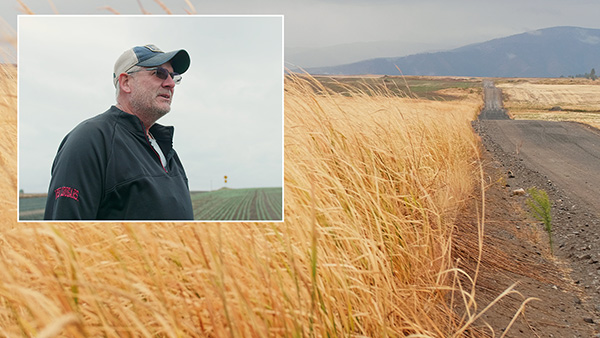
Douglas Poole farms wheat in central Washington.
He recalls speaking with salesmen about which mix of expensive fertilizers to buy: “They were talking about different fertilizers and why you needed zinc or magnesium or copper or whatever else. But they said, well you got to be careful because if you mix too much of this, well, here’s this Mulder’s chart – it’s going to antagonize these four things over here. You need a little bit of that, but of course, that pisses these four elements off.” From a sales perspective, Mulder’s chart of nutrient interactions seemed to present an opportunity to sell him countless elements and then more elements to counteract the effects of those.
But what does this major expense do to help him? Poole continues: “My biggest weed around here is a Russian thistle. What does a Russian thistle love? High nitrate. What do I do? I keep continuing to put nitrates in the soil and all I’m doing is helping the Russian thistle out. Which of course makes the Roundup salesman happy because I got to have more Roundup to control the Russian thistle. People that are around soil health know this vicious cycle. I just think there’s a positive cycle out of this.”
To Poole, the way out is right there under his toes – “just get out of the way of the soil biology.” No added elements or chemicals, just apply compost and let nature do the rest. Growing plants is “biology, not chemistry,” he sums up. (“And,” he adds, “I don’t have to write a check for it.”) Watch an interview with Douglas Poole.
Two states over in Montana, Cory Miller also extols the benefits of soil biology. Formerly a developer of natural cleaning products, he now farms a thousand-acre ranch producing sod, hay, beef, pork, and honey. He also shares his enthusiasm for soil biology and regenerative practices on a popular YouTube channel.
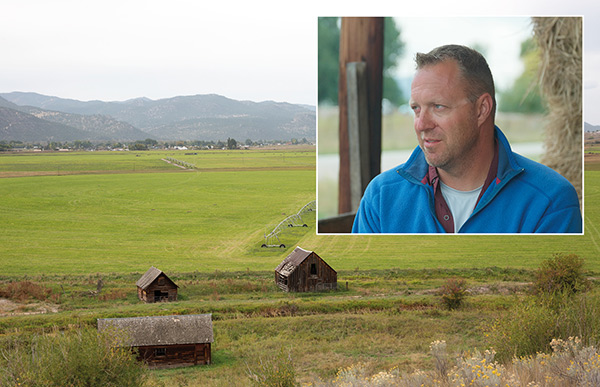
Cory Miller’s ranch in Montana produces sod, hay, beef, pork, and honey.
He doesn’t wax eloquent about going green or saving the planet, although those considerations are something he finds important. Like Poole, he goes straight to the financial benefits: “I got this place, and I had six months to figure out how to make it make money and to do that without a significant investment in infrastructure,” he says. The eye-popping cost of fertilizer made him seriously consider “how to build something more resilient that can be sustainable over the long term. Everything pointed to biological farming and letting biology release the nutrients in the soil.”
He commiserates with others facing this transition. “You can waste a lot of money farming, a lot of money, and you have to set some limits on where you go to find your success.”
These farmers have found their success by recommitting to a knowledge of the soil and respect for natural cycles. In embracing a profitability mindset, the implementation of regenerative practices enabled them to reclaim financial independence.
The benefit to the bottom line is not the only important tenet of regenerative agriculture. For one, healthier soil makes for healthier food. As Miller puts it, “The density of nutrition that we can pack into food is the number one reason for doing it. There are a lot of bad things that are in our food supply that end up inside our bodies. The science suggests that a lot of this has to do with chemicals in the food we buy at the grocery store.” He continues, “After learning about this and studying it and practicing it, I feel like a totally different person. When I was busy all the time, fast food was the option, just pack it in, eat as quick as I can, get back to work. Now I carry a bag of carrots in the tractor, and I can eat them slow.” Watch an interview with Cory Miller.
Adam Henderson, who farms two thousand acres in Iowa with his brothers Andy and Aaron and their father Bob, elaborates on the scientific connection between soil health and nutrition. He recalls a lightbulb moment he had in a college class when his professor put a slide up “showing the degradation of the nutrient value of corn over the last forty years, how conventional corn compares to the nutrient value of GMO, the difference between starch and protein values.” That stuck with him. Today, “we feed our animals a lot of what we grow, and our animals are healthier, we eat the meat out of those animals, so hopefully we’ll be healthier too. That’s what the whole thing is, to bring it around full circle to where animals are healthy, people are healthier, and soil is healthier.”
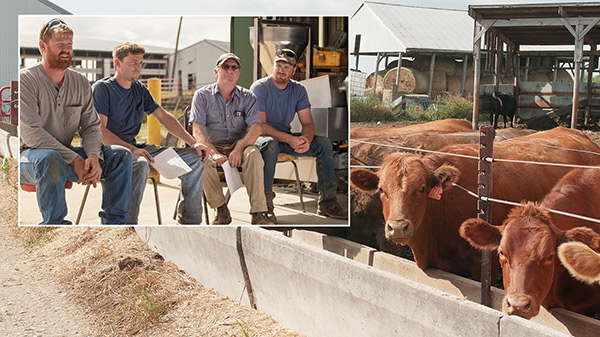
Bob Henderson and his three sons farm two thousand acres in Iowa.
And, last but not least, the earth is healthier as well. As caretakers of land, farmers understand the broader environmental impact of their practices. Regenerative farming can mitigate pollution, conserve water, reduce erosion, and contribute to a more resilient ecosystem.
“Mother Nature does some crazy things,” notes Miller. “She brings hurricanes and tornadoes, and all those things are for a purpose. They’re changing the dynamic of what’s growing.” Being attuned to nature, even at this disruptive level, can help farmers “build something resilient and prepare for those bad years.”
For Clark, it didn’t take a hurricane to bring this point home. He remembers a time when his farm was still high-tillage and “we got a one-inch rain event. Just one inch on a one-percent-slope field. The erosion that occurred just blew me away. The field was on the road. That’s when I woke up and said, ‘It’s time to make a change.’”
Erosion was also a deciding factor for the Henderson family. They started using compost extract, Andy explains, because “if you reduce your erosion, you’re going to have more of your soil and it is going to stay put. So therefore, your nutrients are also going to stay put too. Your water-holding capacity is going to increase and that will help eventually make the crops better in a drought-stress year.”
Over the past ten years, the Hendersons cut back on tilling and made many other changes to the farm as they learned more about regenerative practices, from rotational grazing to monitoring microorganisms. When they started out, Adam recalls, “We knew from soil testing that we didn’t have the biology in the soil. There’s hardly any protozoa.” But year over year, these results have improved, and meanwhile their respect for nature has deepened. “Don’t treat the soil as just a growing medium for plants. There’s more stuff going on down there than there is up top.”
Bob sums up with advice from Gabe Brown, author of Dirt to Soil: “‘I used to go out and figure out what I was going to kill that day, a bug or a weed or something. Now I try to figure out what I’m going to keep alive.’ That’s a huge statement because that’s where we’re at. We’d like to try to keep as much stuff alive as we can instead of trying to kill everything.” Watch an interview with the Hendersons.
Though promising, the journey toward regenerative farming is challenging. Aaron Henderson advises, “There are a ton of risks involved in this, and that’s a huge reason, a huge hurdle, why people don’t just jump full step into it. Baby steps are the key. Slowly work your way into it, figure out how it stays profitable for you, and you’ll slowly see the results over time.”
The transition from conventional practices to regenerative methods may involve initial costs, a learning curve, and a reluctance to change. “As far as jumping headfirst into it,” he continues, “it’s a scary thing financially. But you can see the benefits over the years.”
To be sure, extracting enough beneficial biology from compost to cover a large farm is an operational constraint. Without the right equipment, the process is time-consuming and messy at best. At worst, there is a high likelihood that valuable material will be wasted and even pathogens produced and spread.
I know these challenges firsthand. When the Bruderhof made the shift to regenerative practices on our own farms, we recognized that an abundance of scientific data pointed to the benefits of rebuilding microbial ecosystems in the soil. Currently, all fourteen Bruderhof farms are either fully regenerative or transitioning toward that goal. Yet, as we began implementing regenerative methods, it became clear that there were few tools available to efficiently execute these methods at a large scale. Our solution was to create our own tools to support our farms and others looking to make the same transition.
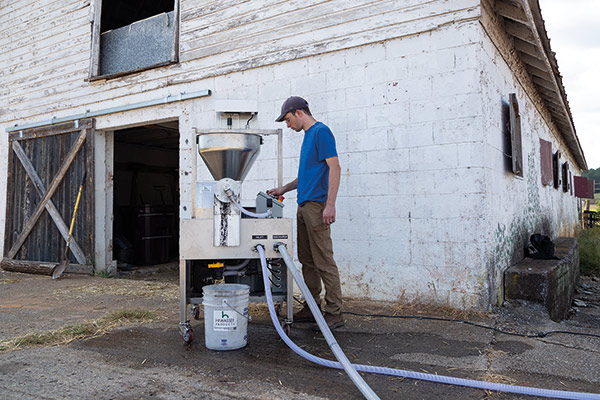
Hiwassee Products’s soil consultant at the controls of the Continuous Flow Bio-Extractor.
At the new Bruderhof on the former Hiwassee College campus in Madisonville, Tennessee, we have recently launched a business endeavor focused on providing equipment solutions for regenerating soil biology. Hiwassee Products makes equipment systems that address biological soil building from composting to extraction to application and the testing of results. These products are geared toward rebuilding soil microbial communities in a way that’s scalable and adaptable to various agricultural systems. We offer equipment solutions that will work for small or large-scale farms, so both can make the shift to more regenerative practices.
Hiwassee Products works closely with farmers, integrating their requests with the advice of the soil lab technician to develop this equipment. These solutions bridge the gap between science and methodology, linking the two by making best practices proven in the lab an operationally efficient reality on the farm. Like the farmers we serve, we are still learning what works in our own fields and workshops. By drawing on the latest science alongside the wisdom of the past, we are striving to help farmers meet the demands of a rapidly changing world. As challenges loom, regenerative agriculture holds the promise of surviving and thriving. Elevating the vitality of soil is a strategic investment in the planet, promoting human health, fostering the growth of nutritious food, and ultimately yielding a profitable bottom line.
Already a subscriber? Sign in
Try 3 months of unlimited access. Start your FREE TRIAL today. Cancel anytime.









































Linda Safford
This seems a spiritual lesson in many ways. I particularly enjoyed this statement: "As Elaine Ingham, founder of the Soil Food Web School, puts it: “If we want clean water, we have to get the biology back in our soils. If we want to grow and harvest crops, we have to build soil and fertility with time, not destroy it. The only way to reach these endpoints is to improve the life in the soil.” On the quest for the biggest, best, most productive, and overall money maker we tend to lose sight of the reason of tending the land. Supplying life to lives is the goal, right? Do we need profitable farmers who put their work into the land? Yes. This article definitely shows us nature does tend to nature. We are caretakers. Let's not kill the land. Regenerative farming, as explained in this report, seems to answer much for the farmer who stewards the land.
Timothy A A Stiles
Thank you, Colin, for a great article. As a financial person, the "profit v yield" argument is very persuasive - hopefully more of the available literature will continue to focus on the quality rather than quantity, and the profitability of that quality.